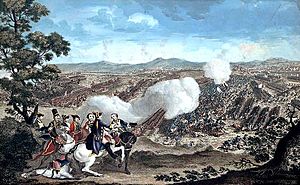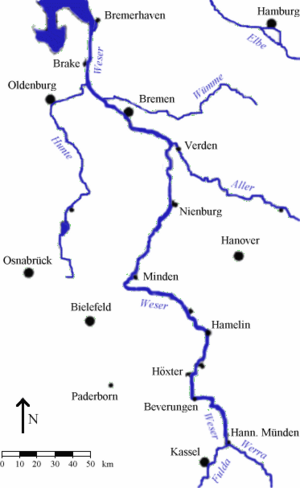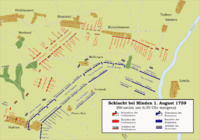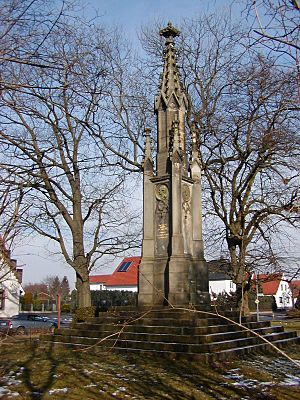Battle of Minden facts for kids
Quick facts for kids Battle of Minden |
|||||||
|---|---|---|---|---|---|---|---|
| Part of the Seven Years' War | |||||||
 The Battle of Minden, unknown painter |
|||||||
|
|||||||
| Belligerents | |||||||
| Commanders and leaders | |||||||
| Strength | |||||||
| 37,000 | 44,000 | ||||||
| Casualties and losses | |||||||
| 2,762 killed, wounded or missing | 7,000 killed, wounded or missing | ||||||
The Battle of Minden was a big fight during the Seven Years' War. It happened on August 1, 1759. An army from Britain and Germany, led by Prince Ferdinand, beat a French army. The French army was led by Marquis de Contades.
A couple of years before, France had taken over Hanover in Germany. They tried to make Britain, Hanover, and Prussia sign a peace treaty. But after Prussia won a battle at Rossbach, and with pressure from Frederick the Great and William Pitt, King George II of Britain said no to the treaty. In 1758, the British and German allies fought back. They pushed the French and Saxon forces all the way back across the Rhine river.
The French then started a new attack. They captured the fortress of Minden on July 10. The French commander, Contades, thought Ferdinand's army was spread out too much. So, he left his strong positions and moved to fight the allies. The most important part of the battle was when six British and two Hanoverian infantry (foot soldier) groups, marching in a straight line, fought off many French cavalry (horse soldier) attacks. Everyone thought these soldiers would be defeated, but they held strong. The allied line then moved forward, making the French army run away. This victory stopped France from trying to take over Hanover for the rest of the year.
In Britain, this victory was a big deal. It was part of what they called the "Year of Miracles" in 1759.
Contents
Why the Battle Happened
The western German states were a main battleground in the Seven Years' War since 1757. That's when the French invaded Hanover. The French won a big battle at Hastenbeck. They tried to force a peace treaty on Hanover, Prussia, and Britain. But Prussia and Britain refused.
In 1758, Prince Ferdinand led a counter-attack. He pushed the French back across the Rhine river. The port of Emden was also taken back, which helped Britain send supplies. The British government had not wanted to get involved directly in Europe before. But now, they sent 9,000 British troops to help Ferdinand during the winter break. The French also sent more soldiers, hoping to win the war quickly.
Ferdinand wanted to beat the French before their extra soldiers arrived. So, he started his attack early in April. But the French, led by Duke de Broglie, stopped Ferdinand's attack at the Battle of Bergen. De Broglie was then promoted to a top military rank. Ferdinand had to retreat north because the French army was now stronger.
Contades, the main French commander, kept moving forward. He took several towns, including the important fortress at Minden on July 10. Some people criticized Ferdinand for not stopping the French. But Ferdinand decided to face the French near Minden anyway.
Contades had a strong defensive spot near the Weser river around Minden. He didn't want to leave it at first. But Ferdinand made a plan to split his army. This would make it look like he was threatening Contades' supply lines. Contades thought Ferdinand's army was spread too thin. He saw a chance to win a big victory. So, he ordered his men to leave their strong positions. They moved onto the plain west of Minden during the night of July 31 and early morning of August 1.
Where the Battle Took Place

The city of Minden was a fortified city in 1759. It sits where the Weser river, which flows north, meets the Bastau. The Bastau is a small, marshy river coming from the west.
The Battle of Minden happened on the flat land in front of the city. This area was to the northwest of Minden. The Weser river was to the east of the city, and the Bastau was to the south.
On July 31, the French troops under Contades were west of the Weser and south of the Bastau. They crossed to the north using five floating bridges during the night and early morning of August 1. Other French troops, led by De Broglie, were already near the Weser. Some were in Minden on July 31. The rest, who were east of the Weser, crossed over to join them that night.
The Battle Itself
The French commander, Contades, did something unusual for the time. He put his cannons in the middle of his army, protected only by his cavalry. His foot soldiers were on the sides. The battle started on the French right side. There, Marshal de Broglie, who led the reserve troops, began firing cannons at the allied left side.
The most important part of the battle happened in the middle. It was famously due to a misunderstanding of orders. Friedrich von Spörcken's division, made up of British and Hanoverian foot soldiers, was supposed to advance when the drums started beating. But they thought they were ordered to advance to the sound of the drums, meaning right away, while beating their drums.
So, these six British regiments and two Hanoverian battalions marched forward to attack the French cavalry. Everyone thought they would be destroyed because the French cavalry was ready. But these soldiers were very disciplined. Even though French cannons were firing at them constantly, they kept their lines tight. They fired their muskets and drove off repeated French cavalry charges. The French lost many soldiers.
Contades, the French commander, was amazed. He reportedly said, "I have seen what I never thought to be possible—a single line of infantry break through three lines of cavalry...!"
With help from the British and Hanoverian cannons, the whole allied line then moved forward. This made the French army run away from the battlefield. Only de Broglie's French troops were able to fight back a little, forming a rear guard to protect the retreating army.
What Happened After
Prince Ferdinand's army lost almost 2,800 men killed or wounded. The French lost about 7,000 men. After the battle, the French retreated south to Kassel. This defeat ended the French threat to Hanover for the rest of that year.
Ferdinand's cavalry commander, Lord George Sackville, was accused of not following orders. He was told many times to bring his horsemen forward and attack, but he waited too long. He asked for a military trial to clear his name. But there was strong evidence against him. The court said he was "unfit to serve His Majesty in any military Capacity whatever." Sackville later became Lord George Germain and was blamed for some problems in the American Revolution.
In Britain, the victory at Minden was celebrated a lot. It was part of Britain's "Year of Victories" in 1759. King George II gave Ferdinand £20,000 and a special award called the Order of the Garter. Minden also made the British support the war in Europe even more. The next year, more British troops were sent to join Ferdinand's army.
In France, the defeat was taken very seriously. The French Chief Minister, Duc de Choiseul, said he was ashamed. He couldn't believe that a group of Hanoverians could defeat the King's army. To find out what went wrong, Marshal d'Estrées was sent to check on the army. Marshal de Contades was then removed from his command and replaced by the Duc de Broglie.
Michel Louis Christophe Roch Gilbert Paulette du Motier, Marquis de La Fayette, a French colonel, was killed by a cannonball in this battle. His son, Gilbert du Motier, marquis de Lafayette, who later became famous in the American Revolution, was not even two years old at the time. Jean Thurel, a 59-year-old French soldier, was badly hurt. He received seven sword cuts, six of them to his head.
Minden Day Traditions
The British army units that fought at Minden still remember this battle today. Their modern-day parts are:
- Royal Artillery
- 12th of Foot (now part of The Royal Anglian Regiment)
- 20th Foot (now part of the Royal Regiment of Fusiliers)
- 23rd Foot (now the 1st Battalion, The Royal Welsh (Royal Welsh Fusiliers))
- 25th Foot (now The Royal Scots Borderers (1st Battalion The Royal Regiment of Scotland))
- 37th Foot (now part of the Princess of Wales's Royal Regiment)
- 51st Foot (now part of The Rifles)
These units are still called "the Minden Regiments."
When the British foot soldiers and artillery were marching to battle, they walked through some German gardens. The soldiers picked roses and put them in their coats. To remember this, each of the Minden regiments celebrates August 1 as Minden Day. On that day, soldiers of all ranks wear roses in their caps. The Royal Regiment of Artillery wears red roses. The Royal Anglians, The Royal Regiment of Fusiliers, and the Princess of Wales's Royal Regiment wear red and yellow roses. The Scots wear red. The Rifles wear white roses from Yorkshire. Because of this tradition and the bravery of the Yorkshire soldiers, August 1 is also celebrated as Yorkshire Day. The Royal Welch Fusiliers don't wear roses on Minden Day. This is because the Minden Rose is already part of their cap badge, so they wear it every day. Artillery regiments with Minden connections also wear red roses.
Two artillery units from the Royal Regiment of Artillery have the Minden battle honor. Soldiers from both 12 (Minden) Battery and 32 (Minden) Battery wear a red rose in their hats on August 1 each year. Both batteries celebrate Minden Day every year. There's a proud saying: 'Once a Minden Man, always a Minden Man.'
Every year since 1967, six red roses have been secretly delivered to the British consulate in Chicago on August 1. A note with the roses lists the six regiments. It says they "advanced through rose gardens to the battleground and decorated their tricorne hats and grenadier caps with the emblem of England." The note adds that these regiments still celebrate Minden Day by wearing roses. The Embassy has asked who sends them, but the person's identity remains a mystery.
In Poetry
- Erasmus Darwin, Death of Eliza at the Battle of Minden
- Rudyard Kipling, "The Men That Fought at Minden" in Barrack-Room Ballads
See also



